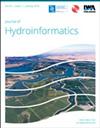Pareto-optimal design of water distribution networks: an improved graph theory-based approach
IF 2.2
3区 工程技术
Q3 COMPUTER SCIENCE, INTERDISCIPLINARY APPLICATIONS
引用次数: 1
Abstract
One of the main drawbacks of using evolutionary algorithms for the multi-objective design of water distribution networks (WDNs) is their computational inefficiency, particularly for large-scale problems. Recently, graph theory-based approaches (GTAs) have gained attention as they can help with the optimal WDN design (i.e., determining optimal diameters). This study aims to extend a GTA to further improve the quality of design solutions. The GTA design is based on a customized metric called ‘demand edge betweenness centrality’, which spatially distributes nodal demands through the weighted edges of a WDN graph and provides an estimation of water flows. Assigned edge weights can be constant (i.e., static) or modified iteratively (i.e., dynamic) during the design process, leading to different flow estimations and alternative design options. Three hydraulic-inspired dynamic weights are developed in this study to better reproduce hydraulic behavior and, consequently, find better solutions. Additionally, this work proposes a framework for the optimal design of multi-source WDNs and provides guidelines for obtaining near-optimal solutions in such networks. A comparative study between GTAs and evolutionary optimizations confirms the efficiency of the improved GTA in providing optimal/near-optimal solutions, especially for large WDNs, with a runtime reduction of up to seven orders of magnitude.配水管网Pareto优化设计:一种基于图论的改进方法
将进化算法用于配水网络(WDN)的多目标设计的主要缺点之一是其计算效率低,尤其是对于大规模问题。最近,基于图论的方法(GTA)引起了人们的关注,因为它们可以帮助优化WDN设计(即确定最佳直径)。本研究旨在扩展GTA,以进一步提高设计解决方案的质量。GTA设计基于一种称为“需求边缘介数中心性”的定制度量,该度量通过WDN图的加权边缘在空间上分布节点需求,并提供水流估计。在设计过程中,分配的边缘权重可以是恒定的(即静态的)或迭代修改的(即动态的),从而产生不同的流量估计和替代设计选项。本研究开发了三种受水力启发的动态配重,以更好地再现水力行为,从而找到更好的解决方案。此外,这项工作提出了多源WDN的优化设计框架,并为在此类网络中获得接近最优的解决方案提供了指导。GTA和进化优化之间的比较研究证实了改进的GTA在提供最佳/接近最佳解决方案方面的效率,尤其是对于大型WDN,其运行时间减少了多达7个数量级。
本文章由计算机程序翻译,如有差异,请以英文原文为准。
求助全文
约1分钟内获得全文
求助全文
来源期刊

Journal of Hydroinformatics
工程技术-工程:土木
CiteScore
4.80
自引率
3.70%
发文量
59
审稿时长
3 months
期刊介绍:
Journal of Hydroinformatics is a peer-reviewed journal devoted to the application of information technology in the widest sense to problems of the aquatic environment. It promotes Hydroinformatics as a cross-disciplinary field of study, combining technological, human-sociological and more general environmental interests, including an ethical perspective.
 求助内容:
求助内容: 应助结果提醒方式:
应助结果提醒方式:


